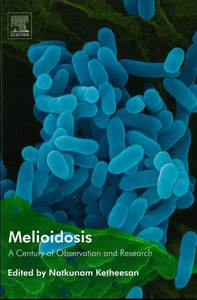The influence of anthropogenic environmental changes upon Burkholderia pseudomallei
Kaestli, Mirjam, and Warner, Jeffrey (2012) The influence of anthropogenic environmental changes upon Burkholderia pseudomallei. In: Ketheesan, Natkunam, (ed.) Melioidosis: a century of observation and research. Elsevier, The Netherlands, pp. 371-376.
![[img]](https://researchonline.jcu.edu.au/26527/4.hassmallThumbnailVersion/26527_cover.jpg)
|
Image (JPEG) (Book Cover)
- Cover Image
Download (161kB) |
|
|
PDF (Published Version)
- Published Version
Restricted to Repository staff only |
Abstract
Mankind has been altering the natural environment for thousands of years. Although the influences are most obvious on macroflora and -fauna, microbial communitiesare also affected. Ruman activity has also recently been linked to the distribution and dispersal of Burkholderia pseudomallei. In endemic regions, the prevalence in soil of the bacteria may be increased due to land-use practices, agriculture, irrigation and the import of pasture grasses. Clear correlations exist with the incidence of melioidosis and rice and livestock farming, and building practices that expose B. pseudomallei from deeper levels in the soil. Rumans have been involved in the dispersal of the organism, from the ancestral origins of Australia throughout the traditional endemic regions of Asia, as weU as to non-endemic areas, a c1assical example of the latter being "l'affaire du Jardin des Plantes". Studying human interactions with B. pseudomallei is critical to understanding melioidosis epidemiology. © 2012 Elsevier B.Y. AU rights reserved
| Item ID: | 26527 |
|---|---|
| Item Type: | Book Chapter (Research - B1) |
| ISBN: | 978-0-444-53479-8 |
| Date Deposited: | 19 Apr 2013 03:03 |
| FoR Codes: | 11 MEDICAL AND HEALTH SCIENCES > 1108 Medical Microbiology > 110801 Medical Bacteriology @ 100% |
| SEO Codes: | 92 HEALTH > 9201 Clinical Health (Organs, Diseases and Abnormal Conditions) > 920109 Infectious Diseases @ 100% |
| Downloads: |
Total: 366 Last 12 Months: 3 |
| More Statistics |



